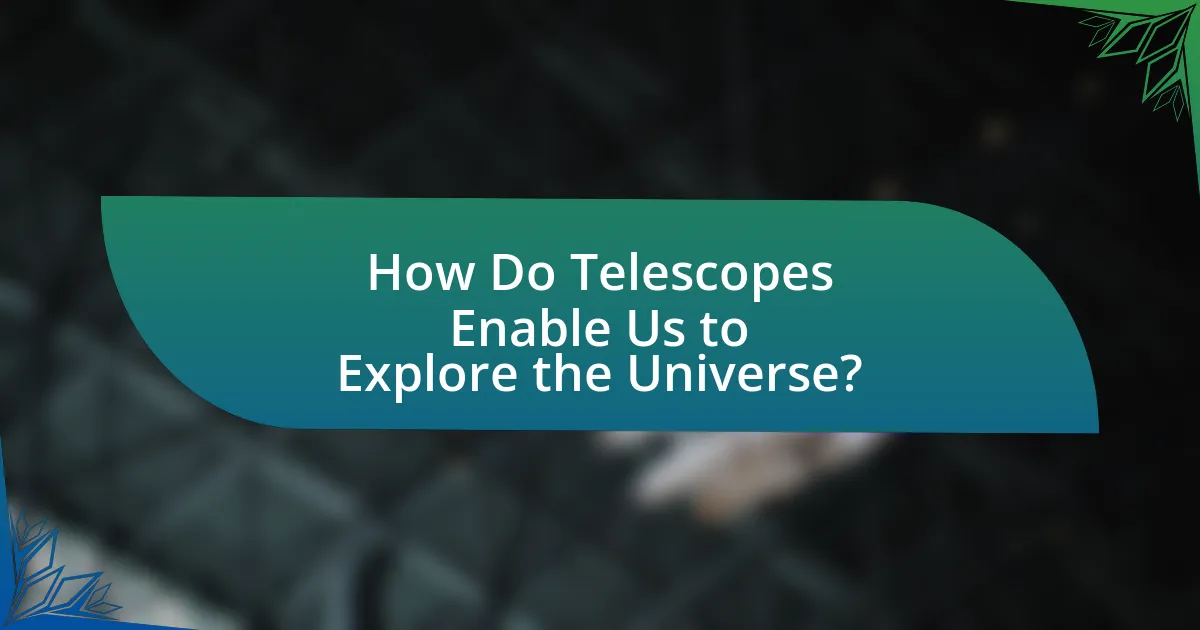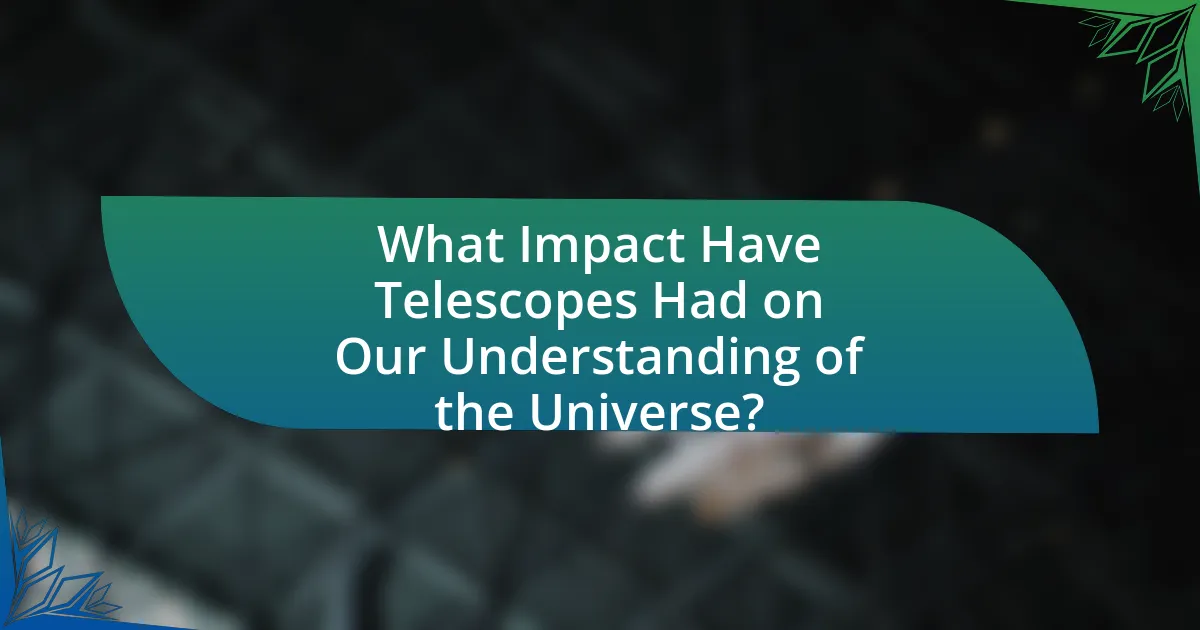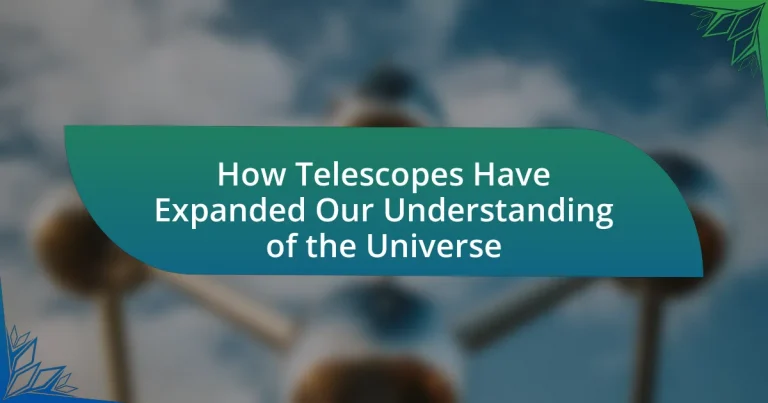Telescopes have significantly expanded our understanding of the universe by enabling detailed observations of celestial objects and phenomena. The article outlines the historical milestones in telescope development, from the refracting telescope invented by Hans Lippershey to modern advancements like the Hubble Space Telescope and the upcoming James Webb Space Telescope. It discusses how telescopes have contributed to major astronomical discoveries, including the identification of exoplanets, the study of black holes, and insights into the universe’s expansion. Additionally, the article examines the technological innovations that enhance observational capabilities and the implications of these discoveries for humanity’s understanding of its place in the cosmos.

How Have Telescopes Changed Our Perspective on the Universe?
Telescopes have fundamentally transformed our perspective on the universe by enabling humanity to observe celestial objects far beyond the capabilities of the naked eye. The invention of the refracting telescope in the early 17th century allowed astronomers like Galileo to discover moons orbiting Jupiter and the phases of Venus, providing evidence that not all celestial bodies revolve around the Earth.
Subsequent advancements, such as the development of the reflecting telescope by Isaac Newton and the introduction of large observatories, expanded our ability to study distant galaxies, nebulae, and other cosmic phenomena. For instance, the Hubble Space Telescope, launched in 1990, has captured images of galaxies billions of light-years away, revealing the universe’s vastness and the existence of dark energy, which constitutes approximately 68% of the universe.
These observations have led to significant paradigm shifts in cosmology, including the understanding of the Big Bang theory and the expansion of the universe. Telescopes have thus not only enhanced our knowledge of the cosmos but have also reshaped our philosophical and scientific understanding of humanity’s place within it.
What are the historical milestones in telescope development?
The historical milestones in telescope development include the invention of the refracting telescope by Hans Lippershey in 1608, which allowed for the first systematic astronomical observations. Galileo Galilei improved upon this design in 1609, using a telescope to observe celestial bodies, leading to significant discoveries such as the moons of Jupiter. In 1668, Isaac Newton developed the first reflecting telescope, which eliminated chromatic aberration and improved image quality. The 18th century saw the construction of larger telescopes, such as the 40-foot telescope built by William Herschel in 1789, which expanded the field of astronomy. The 20th century introduced radio telescopes, with the first operational radio telescope built by Karl Jansky in 1932, enabling the study of cosmic phenomena beyond visible light. These milestones collectively advanced our understanding of the universe by providing clearer and more detailed observations of celestial objects.
How did early telescopes contribute to our understanding of celestial bodies?
Early telescopes significantly advanced our understanding of celestial bodies by enabling astronomers to observe details that were previously invisible to the naked eye. For instance, Galileo’s use of the telescope in the early 17th century revealed the moons of Jupiter, demonstrating that not all celestial bodies orbit the Earth, which challenged the geocentric model of the universe. Additionally, telescopes allowed for the observation of the phases of Venus, providing further evidence for the heliocentric model proposed by Copernicus. These observations were pivotal in shifting scientific consensus towards a more accurate understanding of the solar system and the nature of celestial mechanics.
What advancements in telescope technology have occurred over time?
Advancements in telescope technology have significantly enhanced our ability to observe the universe. The invention of the refracting telescope in the early 17th century by Galileo marked the beginning of modern astronomy, allowing for the first detailed observations of celestial bodies. The introduction of the reflecting telescope by Isaac Newton in 1668 improved image clarity and eliminated chromatic aberration, leading to more accurate observations.
In the 20th century, the development of radio telescopes expanded our observational capabilities beyond visible light, enabling the study of cosmic phenomena such as pulsars and cosmic microwave background radiation. The launch of space telescopes, like the Hubble Space Telescope in 1990, provided unprecedented views of distant galaxies and nebulae without atmospheric interference, resulting in groundbreaking discoveries about the expansion of the universe.
Recent advancements include adaptive optics technology, which compensates for atmospheric distortion in real-time, and the use of large arrays of telescopes, such as the Very Large Array, which enhances resolution through interferometry. These technological innovations have collectively transformed our understanding of the cosmos, allowing astronomers to explore deeper into space and time than ever before.
Why are telescopes essential for astronomical research?
Telescopes are essential for astronomical research because they enable the observation of distant celestial objects, providing critical data about the universe. By collecting and magnifying light from stars, galaxies, and other astronomical phenomena, telescopes allow scientists to study their properties, such as composition, distance, and motion. For instance, the Hubble Space Telescope has captured images that have led to significant discoveries, including the acceleration of the universe’s expansion, which was evidenced by observations of distant supernovae. This capability to gather detailed information from vast distances is fundamental to advancing our understanding of cosmic events and the overall structure of the universe.
How do telescopes enhance our ability to observe distant objects?
Telescopes enhance our ability to observe distant objects by collecting and magnifying light, allowing us to see celestial bodies that are far beyond the reach of the naked eye. The design of telescopes, such as refractors and reflectors, enables them to gather more light than the human eye can, which increases the visibility of faint objects. For instance, the Hubble Space Telescope can detect light from objects billions of light-years away, revealing details about their structure and composition. This capability has led to significant discoveries, such as the identification of exoplanets and the observation of distant galaxies, thereby expanding our understanding of the universe.
What role do telescopes play in discovering new celestial phenomena?
Telescopes are essential tools for discovering new celestial phenomena by enabling astronomers to observe distant objects and events in the universe with high precision. They collect and magnify light from celestial bodies, allowing for the detection of previously unseen stars, galaxies, and other astronomical events such as supernovae and exoplanets. For instance, the Hubble Space Telescope has contributed to the discovery of thousands of exoplanets and has provided insights into the expansion of the universe, demonstrating the critical role telescopes play in advancing our understanding of cosmic phenomena.
What types of telescopes exist and how do they differ?
There are three main types of telescopes: refracting telescopes, reflecting telescopes, and catadioptric telescopes. Refracting telescopes use lenses to bend light and focus it, while reflecting telescopes utilize mirrors to gather and reflect light to a focal point. Catadioptric telescopes combine both lenses and mirrors to enhance image quality and portability. Each type differs in design and functionality, affecting factors such as image clarity, size, and cost. For example, refractors are known for their sharp images but can be expensive for larger sizes, while reflectors are more cost-effective for larger apertures but may require more maintenance.
What are the main categories of telescopes based on design?
The main categories of telescopes based on design are refracting telescopes, reflecting telescopes, and catadioptric telescopes. Refracting telescopes use lenses to bend light and focus images, while reflecting telescopes utilize mirrors to gather and reflect light. Catadioptric telescopes combine both lenses and mirrors to enhance image quality and portability. These design categories are foundational in astronomy, influencing how observations are made and expanding our understanding of celestial phenomena.
How do different telescopes contribute to various fields of astronomy?
Different telescopes contribute to various fields of astronomy by providing unique observational capabilities that enhance our understanding of celestial phenomena. Optical telescopes, such as the Hubble Space Telescope, capture visible light and have led to significant discoveries, including the measurement of the universe’s expansion rate. Radio telescopes, like the Arecibo Observatory, detect radio waves from cosmic sources, enabling the study of pulsars and cosmic microwave background radiation, which provides insights into the early universe. Infrared telescopes, such as the Spitzer Space Telescope, observe heat emitted by objects, allowing astronomers to study star formation in dust-obscured regions. Each type of telescope, through its specialized technology, plays a crucial role in advancing knowledge across different astronomical disciplines, from cosmology to planetary science.

How Do Telescopes Enable Us to Explore the Universe?
Telescopes enable us to explore the universe by collecting and magnifying light from distant celestial objects, allowing for detailed observation and analysis. This capability has led to significant discoveries, such as the identification of exoplanets and the observation of cosmic phenomena like supernovae and black holes. For instance, the Hubble Space Telescope has provided images and data that have expanded our understanding of galaxy formation and evolution, revealing that the universe is approximately 13.8 billion years old. Additionally, telescopes equipped with advanced technology, such as adaptive optics and spectroscopy, enhance our ability to study the composition and behavior of stars and galaxies, further enriching our knowledge of the cosmos.
What are the key features of modern telescopes?
Modern telescopes feature advanced optics, digital imaging technology, and adaptive optics systems. Advanced optics, such as large aperture designs, enhance light-gathering capabilities, allowing for clearer and more detailed observations of distant celestial objects. Digital imaging technology, including CCD sensors, enables high-resolution imaging and data collection, facilitating the analysis of astronomical phenomena. Adaptive optics systems correct for atmospheric distortion in real-time, improving image clarity and resolution. These features collectively enhance the ability to explore and understand the universe, leading to significant discoveries in astronomy.
How does aperture size affect a telescope’s performance?
Aperture size significantly affects a telescope’s performance by determining its light-gathering ability and resolution. A larger aperture allows the telescope to collect more light, which enhances the visibility of faint celestial objects and improves image brightness. For instance, a telescope with an aperture of 10 inches can gather over four times more light than one with a 5-inch aperture, enabling astronomers to observe fainter stars and galaxies. Additionally, a larger aperture improves resolution, allowing for finer detail in images, as it reduces the effects of atmospheric distortion. This principle is supported by the Rayleigh criterion, which states that the resolving power of a telescope is directly proportional to its aperture size. Thus, the performance of a telescope is fundamentally linked to its aperture dimensions, influencing both the clarity and detail of astronomical observations.
What technologies are integrated into contemporary telescopes?
Contemporary telescopes integrate advanced technologies such as adaptive optics, digital imaging sensors, and spectroscopy. Adaptive optics systems correct for atmospheric distortion in real-time, enhancing image clarity and resolution. Digital imaging sensors, including CCDs (Charge-Coupled Devices), capture high-resolution images and allow for long-exposure photography, significantly improving data collection. Spectroscopy techniques enable the analysis of light from celestial objects, providing insights into their composition, temperature, and motion. These technologies collectively enhance observational capabilities, leading to a deeper understanding of the universe.
How do telescopes capture and analyze light from celestial objects?
Telescopes capture and analyze light from celestial objects through a combination of lenses or mirrors that focus light and sensors that convert it into data. The primary function of a telescope is to collect light from distant stars and galaxies, which is then focused to create an image. For instance, optical telescopes use glass lenses or curved mirrors to gather visible light, while radio telescopes capture radio waves using large dish antennas.
Once the light is focused, sensors such as charge-coupled devices (CCDs) or photomultiplier tubes convert the light into electrical signals. These signals are then processed using software to analyze various properties of the light, such as its intensity, wavelength, and polarization. This analysis allows astronomers to determine the composition, temperature, distance, and motion of celestial objects. For example, spectroscopy, a technique used in many telescopes, separates light into its component colors, revealing information about the chemical makeup of stars and galaxies.
What methods are used to process data collected by telescopes?
Data collected by telescopes is processed using methods such as image calibration, data reduction, and spectral analysis. Image calibration involves correcting for instrumental effects and atmospheric distortions to enhance image quality. Data reduction techniques, including noise filtering and background subtraction, help in refining the raw data for clearer analysis. Spectral analysis allows astronomers to interpret the light spectrum from celestial objects, providing insights into their composition, temperature, and motion. These methods are essential for accurate astronomical observations and have been validated through numerous studies, including the analysis of data from the Hubble Space Telescope, which has significantly advanced our understanding of the universe.
How does spectroscopy enhance our understanding of the universe?
Spectroscopy enhances our understanding of the universe by allowing scientists to analyze the light emitted or absorbed by celestial objects, revealing their composition, temperature, density, and motion. This technique enables the identification of chemical elements and molecules in stars and galaxies, providing insights into their physical properties and processes. For instance, the discovery of the redshift in the light from distant galaxies has been crucial in supporting the Big Bang theory, indicating that the universe is expanding. Additionally, spectroscopy has been instrumental in detecting exoplanets and studying their atmospheres, which helps in assessing their potential habitability.
What are the limitations of telescopes in astronomical observations?
Telescopes have limitations in astronomical observations primarily due to atmospheric interference, light pollution, and technological constraints. Atmospheric interference, such as turbulence and weather conditions, distorts the light from celestial objects, affecting image clarity. Light pollution from urban areas obscures faint astronomical objects, making them difficult to observe. Additionally, technological constraints, including the resolution limits imposed by the diffraction of light, restrict the detail that can be captured. For instance, ground-based telescopes are limited by the Earth’s atmosphere, while space telescopes, although free from atmospheric distortion, face challenges such as limited operational lifespans and high costs. These factors collectively hinder the full potential of telescopes in providing clear and detailed astronomical observations.
How do atmospheric conditions impact telescope observations?
Atmospheric conditions significantly impact telescope observations by affecting the clarity and quality of the images captured. Factors such as humidity, temperature, and turbulence in the atmosphere can distort light from celestial objects, leading to blurred or less detailed images. For instance, atmospheric turbulence, often referred to as “seeing,” can cause stars to twinkle and can degrade the resolution of ground-based telescopes. Studies have shown that optimal observing conditions occur at high altitudes where the atmosphere is thinner and more stable, which is why many observatories are located on mountaintops. Additionally, water vapor in the atmosphere can absorb certain wavelengths of light, limiting the ability to observe specific astronomical phenomena.
What challenges do astronomers face with ground-based telescopes?
Astronomers face several challenges with ground-based telescopes, primarily atmospheric interference, light pollution, and limited observational time. Atmospheric interference, caused by turbulence and varying air density, distorts images and reduces clarity, making it difficult to obtain precise data. Light pollution from urban areas further hampers observations by obscuring faint celestial objects, limiting the effectiveness of ground-based observations. Additionally, ground-based telescopes are restricted by the Earth’s rotation and weather conditions, which can significantly reduce the available time for observations. These factors collectively hinder the ability of astronomers to gather accurate and comprehensive data about the universe.

What Impact Have Telescopes Had on Our Understanding of the Universe?
Telescopes have profoundly expanded our understanding of the universe by enabling the observation of distant celestial objects and phenomena. The invention of the optical telescope in the early 17th century allowed astronomers like Galileo to discover moons orbiting Jupiter, challenging the geocentric model of the solar system. Later advancements, such as the Hubble Space Telescope, provided high-resolution images of galaxies, nebulae, and exoplanets, revealing the universe’s vastness and complexity. These observations have led to significant discoveries, including the expansion of the universe, the existence of dark matter, and the identification of thousands of exoplanets, fundamentally altering our comprehension of cosmic structures and the potential for life beyond Earth.
How have telescopes contributed to major astronomical discoveries?
Telescopes have significantly contributed to major astronomical discoveries by enabling detailed observation of celestial objects and phenomena. For instance, Galileo’s use of the telescope in the early 17th century led to the discovery of Jupiter’s moons, which provided evidence against the geocentric model of the universe. Additionally, the Hubble Space Telescope has revealed the existence of exoplanets and provided insights into the expansion of the universe through observations of distant galaxies. These advancements have fundamentally changed our understanding of cosmic structures and the nature of the universe, demonstrating the critical role telescopes play in astronomical research.
What role did telescopes play in the discovery of exoplanets?
Telescopes played a crucial role in the discovery of exoplanets by enabling astronomers to observe distant stars and detect the subtle effects of orbiting planets. The Kepler Space Telescope, launched in 2009, utilized the transit method to identify exoplanets by measuring the dimming of stars as planets passed in front of them, leading to the confirmation of over 2,600 exoplanets. Additionally, ground-based telescopes equipped with advanced spectrographs have been instrumental in analyzing the light from stars to identify the gravitational influence of orbiting planets, further expanding the catalog of known exoplanets.
How have telescopes advanced our knowledge of black holes and galaxies?
Telescopes have significantly advanced our knowledge of black holes and galaxies by enabling astronomers to observe distant celestial objects and phenomena in unprecedented detail. For instance, the Hubble Space Telescope has provided high-resolution images of galaxies, revealing their structure and formation processes, while also detecting the presence of supermassive black holes at their centers through the observation of stellar motion around them. Additionally, the Event Horizon Telescope captured the first image of a black hole’s event horizon in 2019, providing direct evidence of their existence and characteristics. These advancements have led to a deeper understanding of the dynamics of galaxies and the role of black holes in cosmic evolution.
What are the implications of telescope discoveries for humanity?
Telescope discoveries have profound implications for humanity, primarily by enhancing our understanding of the universe and our place within it. These advancements have led to significant findings, such as the identification of exoplanets, which suggests the potential for extraterrestrial life; for instance, the Kepler Space Telescope has confirmed over 2,300 exoplanets since its launch in 2009. Additionally, telescopes have provided insights into cosmic phenomena, such as black holes and dark matter, reshaping our understanding of fundamental physics. The Hubble Space Telescope, for example, has captured images that have allowed scientists to estimate the age of the universe at approximately 13.8 billion years. Such discoveries not only fuel scientific inquiry but also inspire philosophical and existential reflections on humanity’s role in the cosmos.
How do telescope findings influence our understanding of the cosmos?
Telescope findings significantly enhance our understanding of the cosmos by providing detailed observations of celestial objects and phenomena. For instance, the Hubble Space Telescope has captured images of distant galaxies, revealing their formation and evolution over billions of years, which supports the Big Bang theory. Additionally, telescopes like the Kepler Space Telescope have identified thousands of exoplanets, expanding our knowledge of planetary systems and the potential for life beyond Earth. These findings are crucial as they allow astronomers to test theories, refine models of cosmic evolution, and deepen our comprehension of the universe’s structure and dynamics.
What philosophical questions arise from telescope observations?
Telescope observations raise several philosophical questions, primarily concerning the nature of reality, our place in the universe, and the limits of human knowledge. For instance, the discovery of distant galaxies challenges the anthropocentric view of existence, prompting inquiries about whether life exists elsewhere and what that means for humanity’s significance. Additionally, the vastness of the universe observed through telescopes leads to questions about the nature of infinity and the concept of time, as seen in the study of cosmic background radiation, which provides insights into the universe’s origins. These observations compel us to consider the implications of scientific discoveries on metaphysical beliefs and the relationship between observation and understanding, as articulated by philosophers like Immanuel Kant, who argued that our perceptions shape our knowledge of reality.
What are the future prospects for telescope technology and exploration?
The future prospects for telescope technology and exploration include advancements in adaptive optics, space-based observatories, and multi-wavelength observations. These innovations aim to enhance image resolution and sensitivity, allowing astronomers to observe distant celestial objects with unprecedented clarity. For instance, the James Webb Space Telescope, launched in December 2021, is designed to study the universe’s first galaxies and exoplanets, showcasing the potential of next-generation telescopes to revolutionize our understanding of cosmic phenomena. Additionally, projects like the Extremely Large Telescope, expected to be operational in the late 2020s, will further push the boundaries of observational capabilities, enabling detailed studies of dark matter and the formation of stars and galaxies.
How might upcoming telescopes change our view of the universe?
Upcoming telescopes, such as the James Webb Space Telescope and the Extremely Large Telescope, will significantly enhance our understanding of the universe by providing unprecedented resolution and sensitivity to observe distant celestial objects. These advanced instruments will enable astronomers to study the formation of stars and galaxies in greater detail, detect exoplanets with improved accuracy, and analyze the chemical compositions of their atmospheres. For instance, the James Webb Space Telescope is designed to observe infrared wavelengths, allowing it to penetrate cosmic dust and reveal previously hidden structures, thereby expanding our knowledge of the early universe and the evolution of galaxies.
What innovations are on the horizon for astronomical research?
Innovations on the horizon for astronomical research include advancements in space-based telescopes, such as the James Webb Space Telescope (JWST), which is set to revolutionize our understanding of the universe by providing unprecedented infrared observations. These observations will allow scientists to study the formation of stars and galaxies in greater detail than ever before. Additionally, the development of next-generation ground-based observatories, like the Extremely Large Telescope (ELT), will enhance our ability to observe exoplanets and their atmospheres, further expanding our knowledge of potentially habitable worlds. These innovations are supported by significant investments from organizations like NASA and the European Southern Observatory, which aim to push the boundaries of astronomical research and discovery.
What practical tips can be applied when using telescopes for observation?
To enhance telescope observation, users should ensure proper alignment and calibration of the telescope before use. This involves adjusting the finderscope to match the main telescope’s view, which improves accuracy in locating celestial objects. Additionally, observing during stable atmospheric conditions, known as “seeing,” allows for clearer images, as turbulence can distort views. Using appropriate filters can also enhance visibility of specific celestial features, such as lunar details or planetary atmospheres. Furthermore, allowing the telescope to acclimate to the outdoor temperature minimizes image distortion caused by thermal currents. These practices are supported by amateur astronomy guidelines, which emphasize the importance of preparation and environmental conditions for optimal observation experiences.




